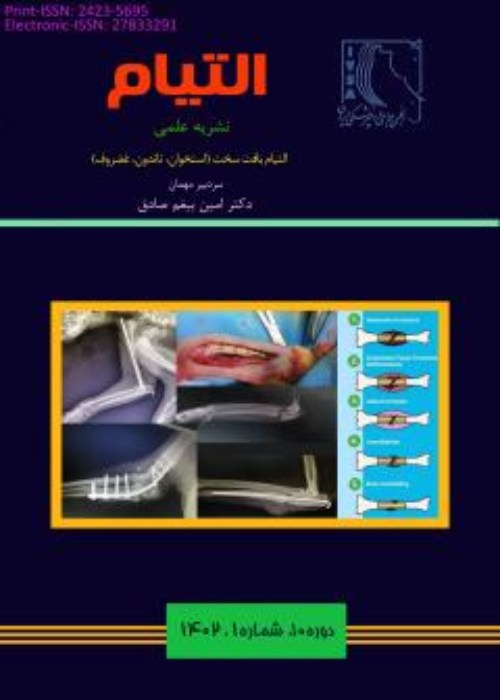Thyroid glands: diseases and laboratory diagnosis in small animals
Author(s):
Article Type:
Research/Original Article (ترویجی)
Abstract:
Thyroid diseases are among the most common endocrine disorders in small animals. Hypothyroidism is a common disease in dogs, but spontaneous hypothyroidism is very rare in adult cats. Hyperthyroidism is one of the most common diseases of cats and is uncommon in dogs. Hypothyroidism is primarily a disease of middle aged to old dogs with clinical signs including weight gain to obesity, lethargy, dull haircoat, cold intolerance detected as heat-seeking behavior, decreased libido, reproductive failure, alopecia with no pruritus, and hyperpigmentation in areas of alopecia. Laboratory abnormalities may include mild anemia, increased liver enzymes and increases in muscle enzymes (CPK). Hypertriglyceridemia and hyperlipidemia occurs in a majority of cases. Hypercholesterolemia is seen in approximately 80% of hypothyroid dogs and a serum cholesterol concentration greater than 500 mg/dL is very suggestive of hypothyroidism. Basal concentration of total T4 should be the initial endocrine diagnostic test utilized when hypothyroidism is suspected. However, approximately 20% of dogs without hypothyroidism may also have decreased TT4. In addition, total T4 may be in the normal range in about 10% of dogs with hypothyroidism. Therefore, it is important to measure other endocrine tests (free T4 and TSH concentrations). The challenging cases may require more intensive diagnostic procedures such as repeat testing in 4 weeks and/or stimulation tests (TSH or TRH). Hyperthyroidism is the most common endocrine disease of cats. Hyperactivity, weight loss, and polyphagia in a middle aged to old cat are the most frequent clinical problems. Increase in one or more liver enzymes, azotemia, hyperphosphatemia and erythrocytosis are the most consistent lab abnormalities of the hyperthyroid cats. If a cat has some of the physical and clinical laboratory abnormalities characteristic of hyperthyroidism, and an increased TT4 concentration, it is diagnostic of hyperthyroidism and fT4 or any additional tests are not needed. When faced with conflicting clinical signs and lab data while trying to confirm a diagnosis of hyperthyroidism, other endocrine tests such as repeating total T4 in 1-2 weeks, free T4 concentration, T3 suppression test and/or stimulation tests (TSH or TRH) should be considered.
Keywords:
Language:
Persian
Published:
Journal of Eltiam, Volume:5 Issue: 1, 2018
Pages:
51 to 65
magiran.com/p1907577
دانلود و مطالعه متن این مقاله با یکی از روشهای زیر امکان پذیر است:
اشتراک شخصی
با عضویت و پرداخت آنلاین حق اشتراک یکساله به مبلغ 1,390,000ريال میتوانید 70 عنوان مطلب دانلود کنید!
اشتراک سازمانی
به کتابخانه دانشگاه یا محل کار خود پیشنهاد کنید تا اشتراک سازمانی این پایگاه را برای دسترسی نامحدود همه کاربران به متن مطالب تهیه نمایند!
توجه!
- حق عضویت دریافتی صرف حمایت از نشریات عضو و نگهداری، تکمیل و توسعه مگیران میشود.
- پرداخت حق اشتراک و دانلود مقالات اجازه بازنشر آن در سایر رسانههای چاپی و دیجیتال را به کاربر نمیدهد.
دسترسی سراسری کاربران دانشگاه پیام نور!
اعضای هیئت علمی و دانشجویان دانشگاه پیام نور در سراسر کشور، در صورت ثبت نام با ایمیل دانشگاهی، تا پایان فروردین ماه 1403 به مقالات سایت دسترسی خواهند داشت!
In order to view content subscription is required
Personal subscription
Subscribe magiran.com for 70 € euros via PayPal and download 70 articles during a year.
Organization subscription
Please contact us to subscribe your university or library for unlimited access!


